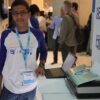Wednesday, June 26th, 2013 by
Brothers John and Mark Lewandowski may soon launch a global health revolution, by inventing a portable, cheap, fast and easy to use device for early malaria diagnosis. Their invention may not only prevent the death of millions who have already contracted the disease, but also lead to a drastic reduction of incidences of malaria.

Mark and John Lewandowski
Malaria is a leading cause of death in the world. Around 300-500 million people are infected with malaria each year. In 2010 alone, an estimated 660,000 people died from the disease. Caused by parasites of the Plasmodium species, malaria is easily transmitted to people when infected mosquitoes bite them. It is most common in sub-Saharan Africa and some parts of Asia and Latin America. While continuing to claim countless lives on a yearly basis, malaria can be cured, especially if detected in its early phases.
The young inventors’ device, called the Rapid Assessment of Malaria (RAM), diagnoses malaria in less than one minute with just one drop of blood from a fingertip. John first thought up the devise in his graduate research at Case Western Reserve University where he studied inexpensive techniques to manipulate malaria parasites with magnetism.
RAM uses magnets and a laser pointer to conduct the diagnosis. Mark explained that the laser “shoots through the blood sample and the magnetic malaria particles interact with the magnets’ magnetic field and come together. Whatever light gets through the sample is captured by the light sensors and transformed into a voltage,” which reveals if and how much malaria a person has.
Listen to John and Mark explain their remarkable device:
The RAM device is reusable, both as a result of its plastic, replaceable sample holder, where the blood is stored, as well as its rechargeable battery. No training is needed to successfully operate the device. The young inventors tested their device on malaria samples sent from Papua New Guinea, where Case Western is operating a clinic. The final version of the RAM will have an LCD screen that will provide an instant diagnosis. This is particularly crucial given the fact that, if detected within the first 24 hours of infection, malaria is easily treatable. If not promptly detected and treated, it can become severe and malaria medication less efficient. Since malaria’s original symptoms include fever and flu-like illness, such as shaking chills, headache, muscle aches, and tiredness, people often fail to diagnose the disease before it is too late. Not only is the disease more difficult to treat later on, but it increases the spread of the disease. With RAM, people can easily test whenever they fear they have contracted the disease.
Another intended addition to the RAM’s final model will be to add an external adapter to ensure that the users can recharge their device with any power source they might have. This is especially important, since malaria affects mostly countries with limited access to energy sources.
The cost of detection will be only 20-25 cents, significantly less than existing malaria detection products. Apart from being more time consuming, existing mechanisms are also more expensive, costing anywhere between 75 cents to over 20 dollars, without considering the additional costs of refrigeration and medical processing. When assessing the total costs, John emphasizes that their product would be 10 times, even 50 times cheaper than everything else on the market.
In order to commercialize their product, the two brothers started their own organization, Disease Diagnostic Group LLC. They want to sell the RAM together with mosquito nets and the malaria treatment. John stressed that putting together prevention, detection and treatment is crucial to quickly reduce the number of malaria cases. The two brothers have reached out to several organizations that might be interested in RAM, including the Gates Foundation and the World Health Organization (WHO). Given the brilliance of their device, it will certainly not take long for organizations interested in global health to show interest in their product.
In propelling their product, John and Mark have already won several $10,000-15,000 business plan competitions and obtained a $100,000 investment from the Coulter Foundation at Case Western Reserve University, which will help them distribute their device in the field. In order to further test it, John and Mark will travel, in the fall of 2013, to Peru and Haiti, two malaria-ridden countries that are relatively close to the U.S.
In terms of upcoming projects, the young entrepreneurs are creating a supplementary app for the RAM to track and store the diagnosis as well as upload it to a GPS mapping system to provide an accurate, minute-changing assessment of malaria affected areas, so that treatment can be efficiently distributed. Also, the brothers hope to help scientists develop new strategies to combat the infectious disease.
When advising other young entrepreneurs to pursue their dreams, Mark suggests: “Take a look a long at all your interests and run them through different scenarios and see which one is going to have the greatest impact on the people around you and other parts of the world.” John added: “The beauty of our business model has been pairing something that has huge social impact with financial profitability or sustainability. So, make sure that your initiative has a sustainable model around it and that it can reach a significant number of people.”
Watch our full interview with the Lewandowski brothers here.
Subscribe
Sorry, there are no posts.





